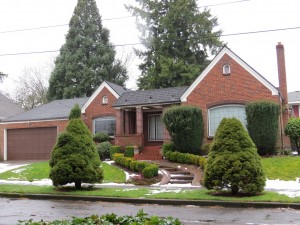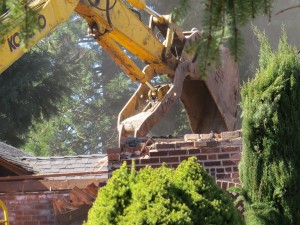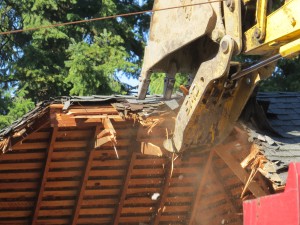
(photo courtesy of Barbara Strunk)
Northeast Portland has lost yet another lovely home. A 1947 building on NE 35th Place was sold to a group of developers in October who are currently demolishing it to build two large houses in its place. This morning I saw one of the many people who walk and drive by this partially demolished house shaking their heads and expressing disbelief that this could happen. The loss of this house is a case study in Portland’s demolition trend.
3419 NE 35th Place
We tried to save the house. The work of neighbors and the Beaumont Wilshire Neighborhood Association resulted in a 120-day delay of demolition when the developers applied for a permit. So why did demolition start well before the delay period ended?

(photo courtesy of Barbara Strunk)
When demolition started (much to the surprise of neighbors who were directed to negotiate a solution during the delay period), we discovered that the City allowed the developers to withdraw the demolition permit (and its 120-day delay) and apply for a “replacement structure” permit, under which no delay was required. The City facilitated this move and no one informed the neighborhood until demo started.
This was a beautiful house in good condition and fitting for its neighborhood. All on one level, it could have been, with remodeling, a wonderful house for aging people or a growing family. A keen gardener owned the property. With the placement of two large houses on the 8,700 square foot lot there will no longer be space for a garden. These houses will be 30 feet high, and set back 5 feet from the sides of the property.
Why it Matters?

(photo courtesy of Barbara Strunk)
This trend is a waste. We are not looking at how to improve current buildings, we are bulldozing, filling landfills and hoping that the new, larger buildings will be better and last as long as the homes built in 1926 or 1949. This new housing does not provide homes for people with less income. When the new houses finally sell they are going for $900,000 – $1.3 million dollars. The sense of place of our older neighborhoods is being lost one house at a time.
I am concerned for the future of neighborhoods like ours. At an increasing rate older homes are being razed and replaced by larger new houses in desirable, older neighborhoods like Beaumont Wilshire, Alameda, Eastmoreland, and Laurelhurst. The City appears to be asking no questions about this, just rubber-stamping the process.
Looking Ahead

(photo courtesy of Barbara Strunk)
While the house on NE 35th Place is gone, we will continue to work with eastside neighborhood groups to change outdated City codes, create disincentives for developers taking this destructive approach, review residential zoning requirements, and improve City communication with neighborhoods. We will not forget this heartbreaking experience in our neighborhood but will use it to get the message to the Portland City Council that responsible code revisions are urgently needed.
Editor’s Note. Restore Oregon has been tracking the demolition trend in Portland and elsewhere across Oregon. While we know not every older building is historically significant or deserving of preservation, steps can be taken at the local level to appropriately manage tear-downs. In the short term, two policy changes would go a long way in empowering neighborhood advocates:
First, planning departments should reclassify demolition as the “removal of more than 50% of perimeter walls.” Under most permitting systems, demolition is defined as 100% of a building being removed. This allows tear-downs that leave just a small piece of a wall to be considered remodels, not new construction.
Second, additional public notification and process is needed. Provisions that require delay or review of demolition applications for buildings over 50 years old allow time for the public to identify alternatives for buildings worthy of preservation. Even if a building is destined for demo, a public process can incentivize salvage and documentation where appropriate.
Additional recommendations for slowing the demolition trend can be found in a February article.

